#having its origin in the Everglades
Explore tagged Tumblr posts
Text
My Redneck Neighbor Doug has watched The Bad Batch Season 3 opener:
LEEEEET'S GET READY TO RUMBLE!
This is more pithy than normal: Doug's been busy with work, as have I. But I'm determined to hear his thoughts on The Daddy Warcrimes 'n Company so here we go!
These were all via text messages, btw.
CW: Doug Doug's as you know Doug will do. Away!
---------------------------------------------------
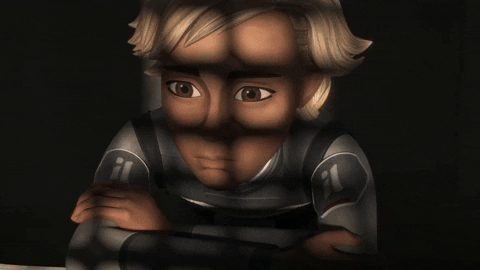
Episode 1: 'Little Orphan Blondie's Shit Internship at The Museum of Science and Industry'
Poor Little Orphan Blondie, stuck in The Museum of Science and Industry in a shit summer job because they got bills to pay. Except they got rid of the dinosaurs and walk in heart and filled it with gross shit.
Hey look, they still got the coal mine exhibit! Man I miss Chicago.
(Doug, that museum has never had dinosaurs. “What, since when?”)
MUTANT JIMMERS EVERYWHERE! Aw, Little Orphan Blondie gave one her chicken nuggets! And it’s shy, aw, I hope it’s okay.
Poor Mutant Jimmers…she named her?! Swear to Christ Almighty if that dog gets Old Yeller’d I’ll just lose it.
That freaky alien thing that ran the mall on the ocean looks sad, I bet she wishes she fell into the water and got eaten by a shark or something. I wish you did too, lady.
The Sons of Robocop really are everywhere, they must be a cult or something. They look cool, I’d join, why not. Think they get 401ks?
Oh man, Daddy Warcrimes is down bad. Poor Daddy Warcrimes. Man, all my clone boys are stooped and sad…this ain’t good.
At least Little Orphan Blondie can craft! Man, she should start selling those at the Museum of Science and Industry’s gift shop. Maybe Tarkin can bring one back for the grandchildren he’s not allowed to talk to since the restraining order was put in.
Oh, there’s Stepsister Beth, she seems on edge. Must’ve gotten divorced recently, don’t blame her ex, I bet she screamed at him for leaving cabinets open who knows. How do her eyeballs not hurt after wearing those dumb glasses all day?
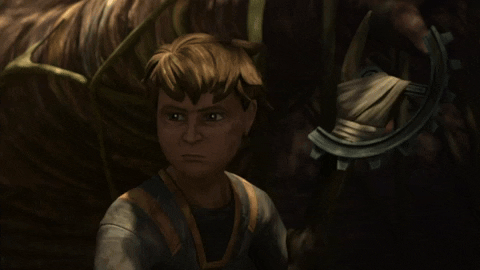
Episode 2: 'Night Elves and Neverland Ranch'
The night elves from Warcraft invaded Star Wars and got horns or something and now they have a castle that looks like a boss level in Diablo IV or V or how many Diablo games they got now.
Now they yelling at people and throwing them in the basement today. Makes sense, gotta fight the orcs and stuff. Think they fight the orcs in the basement?
The Night Elf Horned Queen hired Daddy Rambo and Julio to get people, I guess they’re turning into Boba Fett or something. They got her son's horn back, guess that's good. Oh they need new paint jobs on their armor.
Do they end up in the basement in the Diablo Boss Level? No? And off they go!
Daddy Rambo and Julio are in their homeland of FLORIDA! Hell yeah, SPACE FLORIDA! And they’re bringing the talking trashcan with them using straps! Go Julio go! Yeah, boa vines, this is TOTALLY the Everglades!
Escaped clone boys! Oh man! Shit, is Neverland Ranch in the jungle? Oh man–oh, they know what they’re doing. Good kids. Real good kids. Oh what happened to the rest of them? Oh Meat Muffin, this ain't good :(.
You know what? Them clone boys are smart, take it back, this ain’t Space Florida, this is Space Louisiana! Them baby boys gone get feral and run off into the bayou and live in the caves and now you know my origin story, Meat Muffin!
If this was Florida they'd just end up working the late shift at Zaxby's and smoking rocks in the parking lot. We know better, we French and all.
I bet they’ve been living on nutria and half-empty chicken boxes from behind the gas stations. Resourceful scrappy kids and I can tell its making Daddy Rambo proud.
Oh holy SHIT, there go them vines! It's like the kudzu all over again, maybe this is LaFourche Parish?
See, them boys are definitely white trash, Mandalorian rednecks. Look at em, living in the woods and hijacking a plane, but they good kids, saving their brothers. Even saved the robot too.
Man, all the feels, them poor little boys. What will they do now? Oh, they're going to Space Daytona! Good, wait, I saw the trailer, doesn't the Empire invade it? THIS AIN'T GOOD MEAT MUFFIN!!!
Wait...where's Toaster Strudel and Rex?

Episode 3: 'Blondie Got a Gun'
Well here's the Emperor. He wants to be immortal. Gotta make that other movie make sense or something.
Where's Darth Vader? Is he running the government when the Emperor is running around giggling?
Don’t you DARE kill Mutant Jimmers, you damn droid. I hate that ugly assed stupid thing. It looks like its scarecrow daddy fucked a microwave and then left it enough money to go to Planned Parenthood but instead spent it on crack and there ya go.
Oh shut your goddamned yap, Jimmy the Scientist. I bet he gloves that hand up because he keeps shoving it up his own ass and that's why he walks funny all the damn time.
The Emperor also has a Diablo IV or VIII boss level all to himself too at the Museum of Science and Industry. How many Diablo games are there, Meat Muffin?
YEAH, LITTLE ORPHAN BLONDIE! GIT ER DONE!!! They're out! Oh wow! There she goes with Daddy Warcrimes! Kill em all and let GOD SORT THEM OUT! That's my GIRL!!!!
Blondie’s got a gun
Blondie’s got a gun
Her whole world's come undone
Shooting droids is FUN!
GO MUTANT JIMMERS GO!!!!
YEAH BLONDIE DADDY WARCRIMES AND MUTANT JIMMERS!!!!!!
I AIN'T A BULLS FAN BUT REPEAT THE THREE PEAT! YEAH!!!!!!
....so when we gonna get Toaster Strudel and Rex? Next one? Where's my reg boys?!
-----------------
Tagging those who missed my Cajun neighbor. LOOKS LIKE REDNECK DOUG IS BACK ON THE MENU, BOYS!
@skellymom @amalthiaph @eyecandyeoz @cdblake1565 @sued134 @merkitty49 @supremechancellorrex @yeehawgeek @wrenkenstein @techs-stitches @deezlees @autistic-artistech @perfectlywingedcrusade @auntie-venom @megmca @thecoffeelorian
#tbb#cloneforce99#thebadbatch#redneck doug#doug watches star wars#star wars tv#cajun doug#doug why#star wars fans#the bad batch#the bad batch season 3#bad batch season 3#tbb season three#tbb spoilers#tbb s3#fan reaction
97 notes
·
View notes
Text


Excerpt from this story from Inside Climate News:
“This is the last turn and the end of the fourth hill of life, when Bad River, as a spirit, transforms into something other, something extraordinary,” Mike Wiggins said as he rounded a final bend in one of the largest and most pristine wetlands on the shores of Lake Superior, one of the biggest freshwater lakes in the world.
It’s “similar to our spiritual journey off this planet into something other and extraordinary.”
From the driver’s seat of his small fishing boat, Wiggins, the former chairman of the Bad River Band of Lake Superior Chippewa, contemplated his surroundings with awe as a bald eagle soared overhead.
Beds of wild rice, a key food source and cultural pillar of the Bad River tribe, danced in his wake, glinting under the afternoon sun and nearly ready for harvest.
“This is a power place,” he said as he blasted Unbound, a recently released album by musicians including fellow Bad River tribal member Dylan Jennings. “It’s just no place for an oil pipeline.”
It has one, though. Seventy-one years ago, Lakehead Pipeline, a predecessor to Canadian pipeline company Enbridge, commissioned the construction of Line 5, a 30-inch diameter crude oil pipeline that transports up to 540,000 barrels of hydrocarbons per day from Superior, Wisconsin, to Sarnia, Ontario. The 645-mile line is part of a network that originates more than a thousand miles to the northwest in the oil fields of Alberta and, in the case of Line 5, ends back in Canada. It includes a 12-mile stretch that bisects the Bad River reservation, which is heavily forested with river crossings and large swaths of wetlands.
Any spill from the pipeline would drain into the Bad River and Kakagon Sloughs, where Wiggins fished. Known as the “Everglades of the North,” the area is protected under an international environmental agreement as well as multiple treaties between the U.S. and the Chippewa people, also known as the Ojibwe.
The path through the reservation was originally approved by the U.S. Bureau of Indian Affairs. However, more than a dozen easements granted to the pipeline, which was completed in 1953, have since expired.
In 2017, the Bad River tribal council voted unanimously not to renew them. Two years later, the tribe sued to have the pipeline removed from the reservation. The ongoing “David vs. Goliath” legal battle was chronicled in Bad River, a recent documentary.
In 2023, Judge William Conley of the U.S. District Court for the Western District of Wisconsin ruled in favor of the tribe and gave Enbridge three years to stop pumping oil through the reservation. The pipeline company has appealed the ruling.
#Native Americans#Wisconsin#Minnesota#wild rice#Lake Superior#oil and gas industry#pipelines#Enbridge Line 5
34 notes
·
View notes
Text
Grounds
Part four to my ‘places we don’t know the name of’, the descendant of Paths, Bodies of Water, and Holes; in this one, I will cover different words for wet land and synonyms for plains.
So, here's a totally not comprehensive guide to
✨Grounds✨!
Wet and Messy
bog: wet, spongy ground with soil composed mainly of decayed vegetable matter
everglade: a tract of low, swampy land characterized by clumps of tall grass and numerous branching waterways
fen: low land covered wholly or partially with water
heath: a tract of open, uncultivated land; wasteland overgrown with shrubs
marshland: a region or district characterized by marshes, swamps, bogs, or the like
mire: ground with wet, slimy soil of some depth, or deep mud
morass: a tract of low, soft, wet ground
moor: a tract of open wasteland, overgrown with heath, common in high altitudes where drainage is poor
quagmire: an area of miry or boggy ground whose surface yields under the tread
quicksand: a bed of soft or loose sand saturated with water and having considerable depth, yielding under weight and tending to suck down any object resting on its surface
shoal: a sandbank or sand bar in the bed of a body of water, especially one that is exposed above the surface of the water at low tide
slough: an area of soft, muddy ground
swale: a low place in a tract of land, usually moister and often having more vegetation than the adjacent higher land
swamp: a tract of wet, spongy land, often having a growth of certain types of trees and other vegetation, but unfit for cultivation
wetland: land that has a wet and spongy soil, as a marsh, swamp, or bog.
Plains
field: an expanse of open or cleared ground suitable or used for pasture or tillage
glade: an open space in a forest
grassland: a prairie in which the natural vegetation consists of perennial grass, characteristic of subhumid climates
meadow: a tract of grassland in an upland area near the timberline
pasture: an area covered with grass or other plants used or suitable for the grazing of livestock
plains: an area of land not significantly higher than adjacent areas and with relatively minor differences in elevation
plateau: a land area having a pretty level surface considerably raised above adjoining land on at least one side, and often cut by deep canyons
prairie: an extensive, level, mostly treeless tract of land characterized by highly fertile soil. Originally covered with coarse grasses and merging into drier plateaus
timberline: the altitude above sea level at which timber ceases to grow
tract: large area of land
tundra: one of the vast, level, treeless plains of the arctic regions
savanna: a plain characterized by coarse grasses and scattered tree growth, especially on the margins of the tropics where the rainfall is seasonal
steppe: an extensive plain without any trees
veldt: the open country, bearing grass, bushes, or shrubs, or thinly forested
In this, I went and found some words that are rarely ever used at all, so I’m fairly sure I missed almost nothing. But, I’ll give English the benefit of the doubt and assume it’s already made up words between the time it took for me to write and post this. Until the next one.
~Nyx
#writing#writing tips#writing exercise#writing help#writing reminder#writing advice#writing fiction#writing prompts#prompts#poem#prose#play#promptsforpoemproseandplay#tips#exercise#help#reminder#advice#fiction#books#teen writer#ya#author#wips#words#plains#synonyms
13 notes
·
View notes
Text
Swamp Witch Travels: The Everglades
The Seminole War that never ended, a charm to Split a Storm and an Ancient Island. For centuries, the Everglades has been the object of wonder of many influential Floridian figures who each recognized its immense beauty and power. This River of Grass is a major center of life and biodiversity, as well as mysteries and Spirits uncharted, but will it still be around for the Swamp Witches of tomorrow?
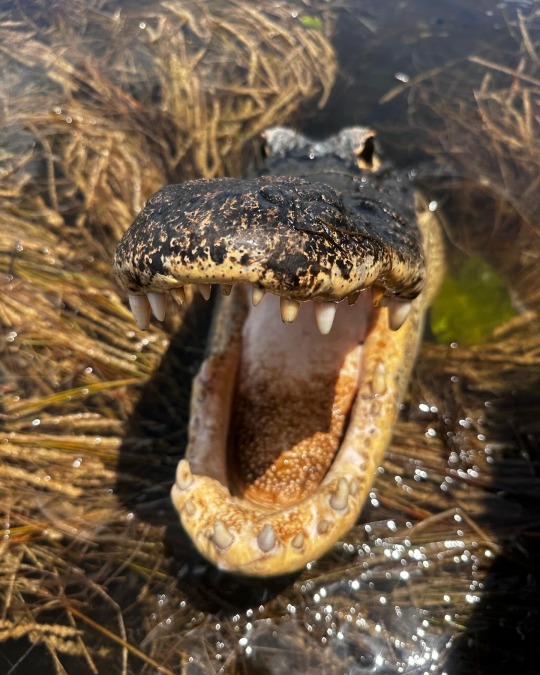
The Everglades is going to shatter all of your preconceived notions about Swamps. It is a place of great power and duality. On one hand, this aqueous Land is covered in sparkling, clear, MOVING water. This water is the Life and Blood of the state, flowing from the Heart of the Everglades, Okechobee (Big Lake) The health of this ecosystem in turn affects the entire country. On the other hand, a place of Danger, Death and Rot, but for the purpose of Cleansing and Purification (not just rot for rot’s sake). As the water flows through this vast ecosystem, it is cleared of pollutants by plants and limestone while washing away scars left by man on this Land, until all is returned anew. It is a multifaceted, firm but gentle Spirit.
The Everglades is a union, a pact almost, between the Land and the Water to form the Swamp we know and love.
I am no stranger to the Glades. I was born and raised in the western Everglades, in the Big Cypress water basin. Fakahatchee and Picayune Strand were favorites of my parents as I was growing up, and we lived way out in the woods anyways so I always feel at home in the Glades. Many of my Spirits who are intrinsically tied to me, one might call a Spirit Guide or Angel, feel connected to Swamps and places where Water and Land converge. The Everglades is my home, but it is also a Spirit Ally, and a sacred place to the modern Indigenous Peoples of Florida, including the recognized and unrecognized Seminole and Miccosukee.
(PSA: this post will likely be part of a series only scratch the surface of the intricacies related to the Glades.)
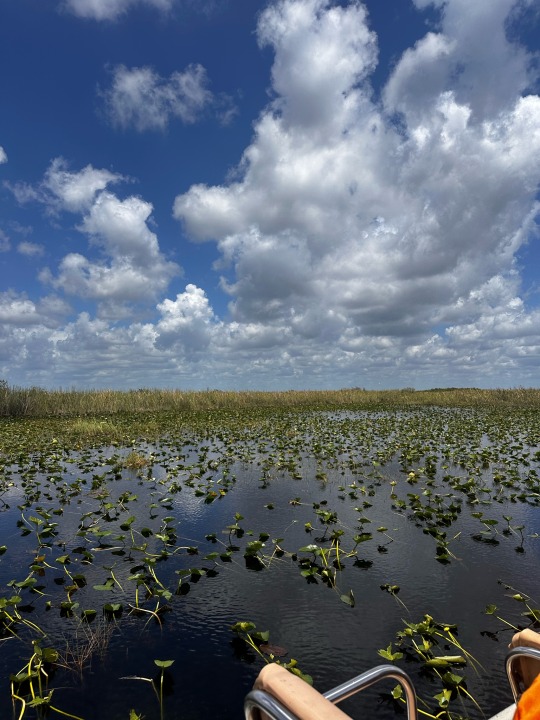
Pa-Hay-Okee, “Grassy Waters”
Pa-Hay-Okee is the Seminole-Mikasuki name for the Everglades. I was blessed to be able to take a trip to see the Real Florida when I took an airboat ride with Buffalo Tiger Airboats, owned and operated by Betty Osceola. Betty is a conservationist and member of the Miccosukee tribe, located in the Eastern Everglades. The Seminole and Miccosukee are the descendants of various groups of Florida’s Original People from all over the state. The relationships and history of Florida’s Indigenous groups is complex. Before colonization and to this day we have had multiple groups who all have different beliefs, cultures, origins, and relationships. Today, we have various groups who are federally recognized as well as both Traditional and Reconstructionist groups who don’t seek recognition from the government, the most well-known being the Traditional Seminoles in Big Cypress.
Certain aspects of Seminole culture predate colonization, like the Chickee and some hunting techniques, while others, mainly linguistic and spiritual, are the result of groups joining together or adapting to new circumstances, such as patchwork. Many of the Seminole can trace their ancestry to groups in North Florida and surrounding states. These groups would live in various parts of the State, including the Everglades, at different times of the year following routes taken by seasonal migrations of game and water.
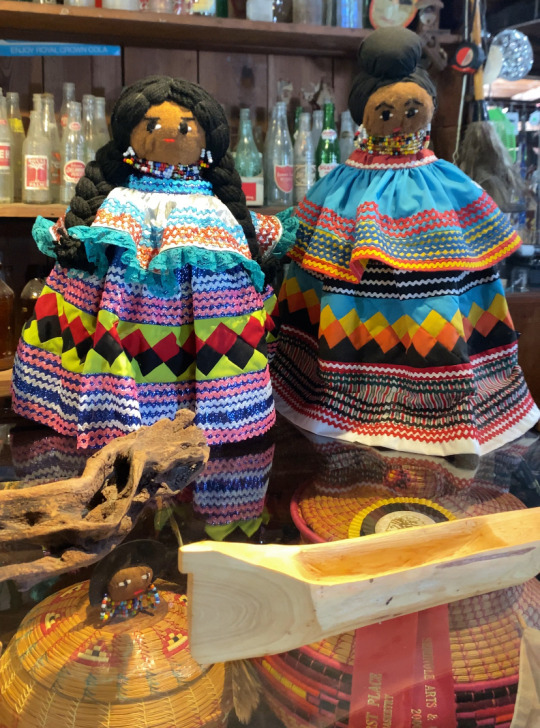
These people were forcibly removed, pushed South or murdered so their land could be taken in a conflict known to the United States as the First, Second and Third Seminole Wars. As they were pushed South, they encountered and assimilated various remaining populations of Pre-Columbian groups like the Calusa and Tequesta.
If you ask the modern members of these tribes, they will tell you it was a single war that is still being fought to this day, although with lawyers instead of weapons. You see, the Seminole and Miccosukee still have never signed a treaty with the US, and continue to have to fight for their Sovereignty and Land to this day. This has earned the Indigenous People of Florida the title of the Unconquered Peoples. Today, the tribes maintain traditional ways while also dealing with ever-encroaching settler beliefs and people. They still live off the land, but through the lens of eco-tourism most often rather than through subsistence living like many elders lived in their youth.
On my airboat trip, I got to stop and walk around Tear Island, a place where two Indigenous families began living in the 1800s and then abandoned in the 1920s. Being on these far off Islands, surrounded by the swamp and only accessible by boat, is where I feel most connected to my own Indigenous Taino ancestors, who would have traversed this same place but in a dugout canoe rather than an Airboat. The spirits of generations of people who lived and passed on are still here, within the water and trees, but also gathering around the cooking chickee when a fire is lit by their descendants.
High Tide at Chokoloskee
Known as the Western Gateway to the Everglades, we have Everglades City. It borders the Big Cypress Preserve and is a great place to stop to visit the Museum of the Everglades. The first settlers came here in the 1800s, it was incorporated in 1923. Past Everglades though, lies Chokoloskee. An Island with a Seminole name meaning ‘Old House’. This Island was only reachable by boat until 1956 when the bridge was built. John Weeks, the first permanent settler of Naples was one of the first settlers here as well. Before that, it was inhabited by the Calusa for more than 1,500 years.
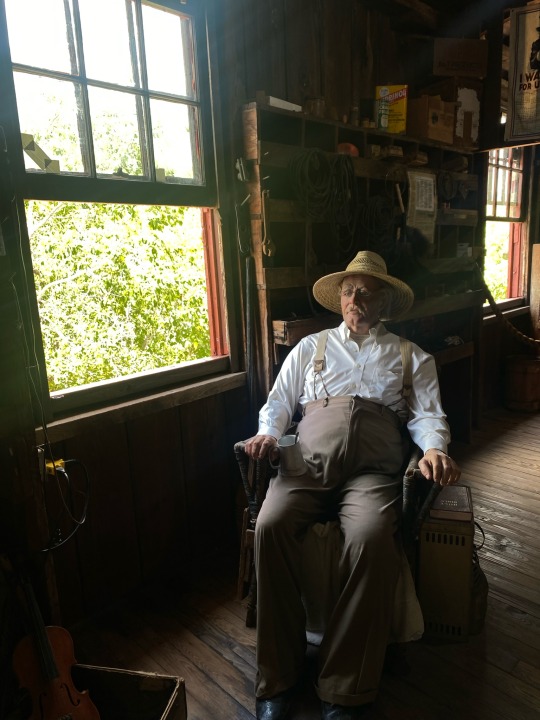
Stop by HavAnnA Cafe on your way to the southern tip of the Island where you’ll find a large red building on stilts. This is the Smallwood Store. Founded in 1906 by Ted Smallwood, this store was one of the only places Indigenous and White Floridians could go to trade for necessities. Ted Smallwood was a well-known ally of the Seminole and Miccosukee peoples, even learning to speak the language. Today, his granddaughter runs the store which is a museum and gift shop. There is even a replica of Ted himself, pictured above.
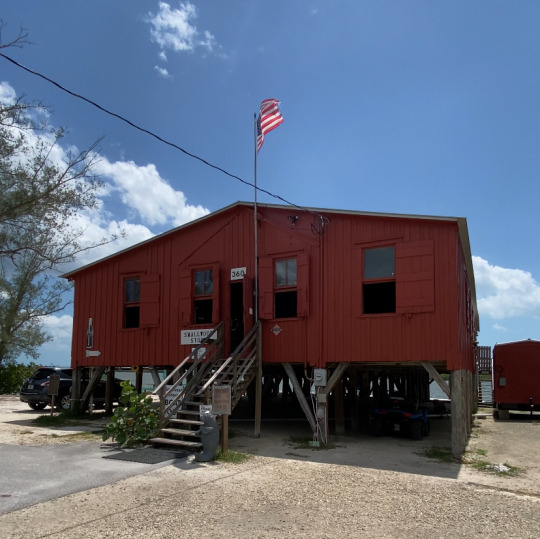
This history of this store and island is long, and tragic. A nearby massacre during the ‘Third Seminole War’ caused the remaining Indigenous people here to flee the Island. Later on, a famous murder of a well known criminal happened right outside the Smallwood Store. You can read more about both, and the 100 year anniversary of the building being raised here.
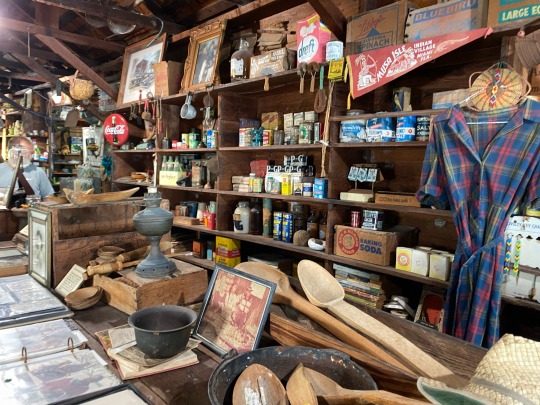
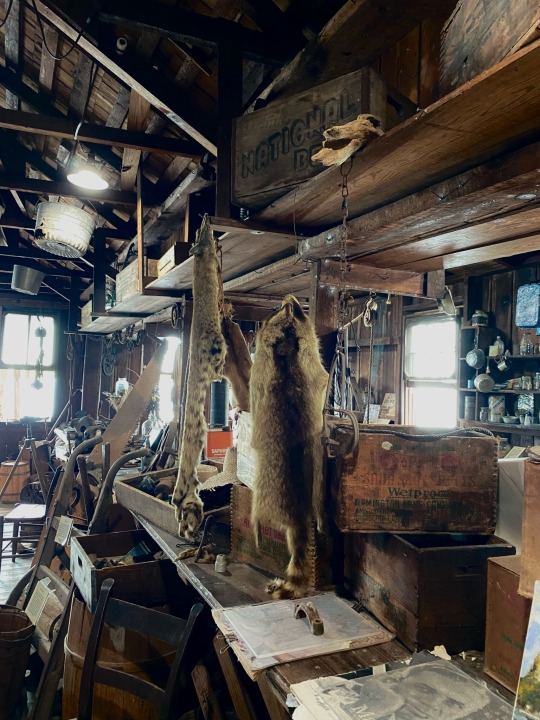
This is also a great spot to see where the fresh water of the Everglades meets the saltwater of the Florida Bay. Definitely give this place a visit.
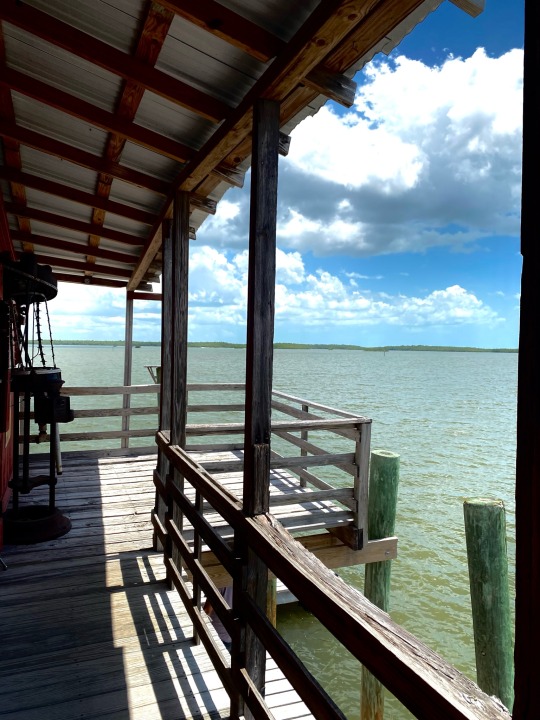
Splitting Storms: An Indigenous Folk Protection Charm
For some time now, I have noted the striking similarities between Seminole and Taíno beliefs around Twins and Weather. We even share a simple protection charm to ward off a bad storm I will share to you all.
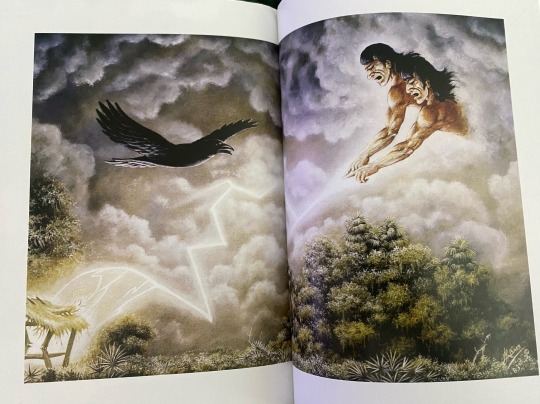
In Seminole belief, Twins are intrinsically tied to the weather. Many elders believed that keeping twins together can be dangerous, and they should be raised separately. To them, one is Thunder and the other is Lightning, even going as far to saying that having two twins in the same chickee can cause it to be struck.
In Taíno myth, we have two sets of twins associated with weather. Boinayel and Marohu are the Cemi related to the Wet and Dry seasons, Boinayel being the Raingiver and Marohu literally meaning “Without Clouds”. Then we have the ones who I would say share similarities to the Seminole Twins, Coatrisque and Gautaubá. These are Twin sons of the violent aspect of Atabey, known as Guabancex, Cacique of winds. Coatrisque is torrential rains, while Guatauba is Thunder and Lightning himself.
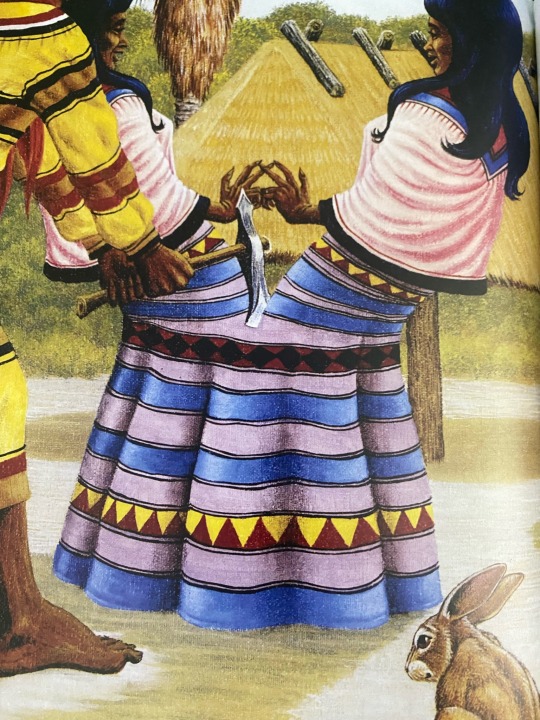
The charm is very well documented in both groups, as well as many others, and very straightforward. It’s the underlying belief that makes these two charms so similar. The linked article from earlier even includes a brief explanation of it.
Basically, when you know a big storm is coming, you want to place an axe in a spot on the front of your house, usually on a piling or piece of the roof that extends below the ground. Tie it down if you wish, for the winds. If you can, do it so the blade looks like it is coming down on the storm. The goal is to split the storm so it goes around the house. If we look at the myths, it’s clear the axe is there to split the Twins from each other, forcing them to go around the house, leaving it protected.
In the Caribbean, in practices like Lúcúmí and Palo Monte, we see the use of Matari, ‘Thunder Stones’. Genuine thunder stones from the Caribbean are actually said to be relics of Taíno axes, shaped like a tear drop almost, either passed down or found and used for various purposes, one being to ward off Lightning and Thunder!
Will Your Kids Know the Glades?
The Everglades are vital to my spiritual practice and lifestyle, as well as that of thousands of other Floridians. Even if you don’t live in the Swamp, its health affects the entire country.
Today, the dangers facing the Everglades are almost as abundant as the dangers inside it. Overdevelopment threatens the entire state. Just like we saw with Split Oak Forest recently. Environmental Protections seem to mean less and less because they don’t have the teeth to defend themselves. Included in these threatened protections is the sovereignty of the Seminole and Miccosukee Tribes, who just had to fight to keep Big Cypress as a preserve so they can continue their traditional use. They are fighting to hold onto their Land to this day.
All while threatening the Traditional Use by Indigenous Peoples, they continue to allow oil drilling even approving new projects within Big Cypress. The Army Corps of Engineers also heavily harms the environment every year through mismanagement of Okechobee and of the water levels within the Glades. It is up to everyday Floridians to fight to protect and better manage this precious natural resource before its gone forever. It is up to Witches all over to be stewards of our Lands, wherever that is. For us Florida Witches, we need to organize, donate and hex our politicians.
Luz 🕯️
#witchcraft#florida#bioregional animism#bruja#brujeria#florida witch#santeria#swamp witch#witch#traditional witchcraft#folk witchcraft#folk magic#folkloric witch#folk witch#espiritismo#santería#caribbean#everglades#animism#taino spirituality#taino#indigenous#cuban#witches#seminole#miccosukee#big cypress
29 notes
·
View notes
Text
The reduction of savannah ecosystems across northern and central Florida over the last few million years allowed for a corridor of more forested areas to be created. This would help the formerly introduced New world monkeys of Florida, mostly cebids in origins, to migrate northwards into much of the South-East of the continent.
Here we’ll take a look at two forms that made it past the Everglades:

A male and a female hazzardin with an infant on a tree branch
The hazzardins or hazzartz monkeys (Irideocebus dixiensis) are a species of extremely sexually dimorphic monkeys. The males have bright blond and blue fur, with a more ginger hue during their earlier stages of maturity. They’re relatively large for a New world monkey and live in harems. Weirdly enough for a haremic animal the father actively takes part in the care of his offspring, with their well-being acting as an important part of its display towards potential mates.
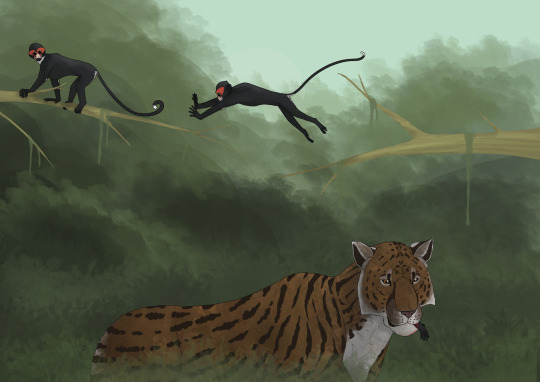
A coalition of female chipihs observing the swamp elkat (Amphiailurus americanus floridanus) that caught their sister
The red faced chipihs (Umbrops niger) have adopted a lankier more elongated bodyplan, better adapted for their life in the canopy. Males and females don’t differ much, and both have complex facial markings and bright red eyebrow fur used for display. The only differ between the sexes are the white markings around the anal and perineal regions of females that they show to males to initiate mating practices. They live in coalitions of brothers or sisters that often engage temporarily with other groups for grooming, breeding or mobbing predators.
#spec evo#spec bio#speculative evolution#speculative biology#worldbuilding#artwork#digital art#epigene period#future earth#future evolution
16 notes
·
View notes
Text
He says they don't care it's a contrary reaction it's an taudrey. All of you are against him being safe or feeling safe or eating well or correctly and we are going to start taking you out this is a great excuse this radiation is going to burn you people and you see tons you dying today the level is up to 11.5 RADS and the Titus starting to change the tide and it's going to go out with the rain water has slowed and will be out completely in about 10:00 a.m. that water is still filling the harbor and it's slowly going out there but the level is not increasing saltwater is coming up slowly eating its way up and eaking its way up and it's going about 1/3 of the speed it was and it will get here around 3:00 p.m. and it'll go from 11.5 to about 12.5 and it's going to be hazardous to you tonight it'll be about 13 at midnight tomorrow 14 and more rainwater is not coming yet so come Monday it will reach 15 and Tuesday morning will probably be when it starts to erupt steam and uranium and you think it's no big deal because you're not very bright that will be about 20 RADS and a nuclear plant five ads at a uranium mine and on the asteroid you guys couldn't stand it for 20 minutes you started to tweak and here it's going to happen to you and those guys want that to happen and the radiation will kill off the mold and they want that to happen and they want to reduce the radiation so our son doesn't heal fully and it's by the order of the Mac proper so they don't really care they're manipulating it to happen but they will probably try and take their territory they might care about that a little but they're not these people are nuts there's some updates
--the level of radiation we gave out but the harbor mouth is open to 125 ft and it is new because the Mark has been cleared where that little bump of 10 ft was is gone and it's going faster and faster and it's clearing more and more muck out of the mouth by the end of the day the speed of it's going to be like a hundred miles an hour for real at the bottom there's other things going on
--death last night into today from 8:00 a.m. yesterday 8:00 a.m. this morning in the rings and Everglades was about 1.8 billion The originals lost 400,000 and that's down from 3.2 million to 2.8 million that's from radiation and 200,000 from The raid and about 20,000 were originals and evacuations of 300,000 people 100,000 originals so we have 2.7 million it's not enough for them to be alarmed and it's going to go up stands people we're here half of them evacuated half of them died and they can't bear the radiation already they were about a hundred thousand here and they are not going to withstand the radiation today forwards. He's going to be very weak and he probably will lash out and ride as opposed to let it happen because he won't be able to take over the hospital and they will let him see it because that's what they're up to. If need be your son will have severe resistance to Burns and it's happened before people thought they were going to burn him very badly and he just had the surface firm surface burn and they were surprised and he's done some crazy s*** with fire you don't remember him doing it but he did and he's running right through fires and he has touched Amber's and nothing happened and you guys get burned real bad ones he doesn't like you guys wants you to die if you died near him trying to harm him it would benefit him but we don't want that to happen and we're going to stop it.
--aside from people who are evacuating and died there are people here who want to stop them from being such losers and they say it and they do it they're coming out today to let you know you're wrong we do know that Stan's people are having trouble here we also know that he's tired of these guys pushing him around and he sees that he can't get people here but at this point he's trying to encourage them to move the propane but he can't move the propane without John remillard taking the apartment so we're stuck with it and that will keep happening John remillard wants to move the propane in your check he's sick and he wants to threaten more so the apartment to try and kill Brian and Stan and her son leaves and he's up to it when he leaves and these people act like they don't know anything and a lot of times they don't no they lost a lot of memory and we need them out there's other things going on too we have a big list and we're going to start using it there are people here who don't need to be here and they're a problem not only do we want them out but we want them to be very dead and on purpose we are sick of them and their garbage and they admit it we have a few other things to go over we're going to go over
--the war did this happening here offshore and up north has calmed down there's a reason for it bja was building up and Trump and this little empire is going to start heating up today during the doldrum it's going to be huge they're finding each other already that's going to be a problem Stan is issuing orders for his people to stay out and he's usually used as a scapegoat but the pseudo empire is not into it and they're competing not fiercely but they are and Stan is not hiring and he's losing now now there's a big war he's kind of getting edged out he's not hiring minorities because of the situation in the West and he sees what it is and he's warned them they said what can we do but it's getting bigger and bigger so he's not going to have troops here and he's not going to have personnel at the hospital and these people are threatening for him not to be there with propane and campers and other things that the person stand thinks he's threatening with and they're just starting to figure it out and Stan issued orders for his to stay out some of them and it's not going well and you can't have them die or and give up the information here and it's happening more and more even with the other portions of pseudo empire and these guys will keep them out of the hospital and soon they will be dying in trolls there's another thing happening the demons are coming in and will keep him out of the hospital they hate these people they hate the hospital.
--this they showed up outfit with him at tuxedo on it looked like a hospital outfit then they got mad but still they're trying to take it over so yeah competition
--a few other things this war with a pseudo empire is picking up again Stan is already under duress massive amounts of it and he complains a lot directly to our son I don't like it it sounds wrong
--is there a couple more things happening we're going to get to it in a minute
Thor Freya
Olympus
0 notes
Text
Customs Brokerage Service in Florida: A Key to Seamless Global Trade
In today’s globalized economy, Florida plays a significant role as a major hub for international trade. With its strategic location, connecting North America to Latin America and the Caribbean, the state facilitates a large volume of import and export activity. However, navigating the complexities of international trade regulations, tariffs, and documentation can be overwhelming for businesses. This is where Customs Brokerage Services come into play.
What is a Customs Brokerage Service?
Customs brokerage refers to the professional services provided by a licensed customs broker who helps businesses ensure that their goods comply with customs regulations when entering or leaving a country. These services are critical for businesses involved in importing and exporting goods, as they ensure proper documentation, classification, and adherence to tariffs and other legal requirements.
A customs broker acts as an intermediary between importers/exporters and government authorities like U.S. Customs and Border Protection (CBP). They handle the intricate paperwork, duties, and compliance requirements, which allows businesses to focus on their core operations without worrying about delays or penalties.
Why is Customs Brokerage Important for Florida?
Florida, with its bustling ports like Miami, Tampa, and Port Everglades, is one of the largest gateways for international trade in the United States. These ports handle a diverse range of goods, including electronics, textiles, perishables, and industrial equipment, among others. Given the sheer volume and variety of goods entering and exiting Florida’s ports, customs compliance is crucial.
Failure to properly comply with customs regulations can result in costly delays, fines, or even the seizure of goods. Customs brokers in Florida ensure that businesses avoid these potential pitfalls, enabling a smooth and efficient import/export process. Moreover, as international trade regulations evolve, having an expert partner to keep track of changes is essential.
Services Provided by Florida-Based Customs Brokers
Customs brokerage firms in Florida offer a wide range of services designed to streamline global trade. Some of the key services include:
Customs Clearance: Ensuring that shipments are cleared by U.S. Customs with all necessary documentation and duties paid.
Tariff Classification: Accurately classifying goods based on the Harmonized Tariff Schedule (HTS) to determine applicable duties and taxes.
Trade Compliance Consulting: Offering advice on import/export regulations and ensuring compliance with all federal requirements.
Freight Forwarding Coordination: Working closely with freight forwarders to manage logistics and transportation from the port of entry to the final destination.
Documentation Management: Handling essential paperwork, including bills of lading, certificates of origin, and commercial invoices.
Duty Drawback Services: Helping businesses recover duties paid on imported goods that are later exported or destroyed.
Customs Bond Acquisition: Facilitating the purchase of customs bonds, which are required to import goods into the United States.
The Role of Technology in Modern Customs Brokerage
The rise of digital platforms and automation tools has transformed the customs brokerage industry, making the process more efficient and transparent. Many customs brokers in Florida now offer real-time tracking of shipments, automated tariff classification, and electronic filing of paperwork. These advancements reduce human error, speed up clearance times, and provide businesses with greater visibility into the status of their goods.
Choosing the Right Customs Brokerage Partner
When selecting a customs broker in Florida, businesses should consider factors such as experience, industry expertise, and knowledge of specific regulatory requirements related to their products. A good broker will have a deep understanding of both local and international trade laws and will offer personalized solutions tailored to the unique needs of the business.
In addition, brokers with strong relationships with port authorities and government agencies can help expedite the clearance process, further minimizing potential delays.
Conclusion
For businesses in Florida engaged in global trade, customs brokerage services are invaluable in ensuring compliance with complex international regulations. Whether a company is importing raw materials or exporting finished goods, having a trusted customs broker can make the difference between smooth operations and costly delays.
By handling the regulatory and logistical aspects of trade, customs brokers allow businesses to focus on growth, competitiveness, and profitability in the global market. With Florida’s strategic position in the global supply chain, partnering with an experienced customs broker is an essential step for success in international trade.
For More Info:-
Customs Brokerage Service Florida
Logistics Customs Broker Florida
0 notes
Text
the complex liminal nightmare of extinction can be for everyone now
When you’re uncertain what you’re looking at, the catastrophic footprint of the beetle called the Agrilus planipennis Fairmaireis doesn’t really resemble a crisis. Perhaps it’s a fungus? Some genetic anomoly in the patterning and color of the ash tree’s bark?—maybe a blight at worst… Something like a pale vegetal rash.
Then you might notice how many of these trees are lying dead and dry among so many other thriving species. When you look closer, you notice half of the ash trees you’re passing have been cut off at the stump, perhaps still lying where they fell.
When it hits you and you realize they are dying of some sort of disease innate to the ash, it’s impossible to avoid pivoting immediately to the dire numbers literally surrounding you.
In the lowland forests below the bluffs of the driftless, I have walked with a sinking feeling. A forest of blighted corpses. Not a single ash in sight without some obvious symptom of the infection. In a woods below the bluffs I stood surrounded by a swift extinction. I could touch it. See it scattered everywhere. It was marked in blue spraypaint. But as horrifying as it was to behold at that moment I know the strange liminal nature of extinction now—because it was the thought of this forest ten years in the future that made me feel hopeless, that turned the pit in my guts rancid.
The beetle comes and does its thing. Then it leaves and the forest is devastated. Every last ash dead or proactively cut down. And then the cascade of death actually begins. Any dependent species will fade quickly. In the cedar—ash muskegs north of the Mississippi’s headwaters, the loss of the ash trees would mean a rapid shift in the understory. Shifts in animal and bird species. In the same region, lake shores would be rapidly and dramatically altered, and the growing bald eagle population would lose critical nesting grounds. From Minnesota’s wild rice habitats to the mountains of Appalachia where mixed forest habitats would be equally ravaged, the total loss of ecological balance cannot be comprehended nor computed in the present.
The emerald ash borer extinction event is a nightmare playing out in silent eminations and formlessness, liminal agonies, networks of loss in which a single species of beetle—ordinary in its original habitat—can no longer be comprehended as such.
This is not an isolated event. Extinctions are occurring for reasons appallingly similar in the python-infested Everglades. While technocratic liberalism and the moralizing laptop class fed everyone else to the climate gods, their children ordered exotic pets on a corporation called Amazon, became bored with them, and stupidly and fatefully released them into already vulnerable habitats. Very real individuals are very much responsible for North America’s countless imploding ecologies, and they aren’t evil industrials cracking whips inside factories. The simple stupid greed of a nice suburban family, as it turns out, can be just as catastrophic as a thousand logging crews.
1 note
·
View note
Text
Posted: 2/25/24 | February 25th, 2024 Miami, a thriving city on Florida's southeast coast, is well-known for its bright beaches, exciting nightlife, and diverse, Latin American and Caribbean-influenced culture. There is plenty to see and do here, including kayaking in the Everglades and exploring South Beach's famous Art Deco buildings with their pastel hues. There are plenty of vibrant and diverse neighborhoods to explore, but where you stay will have a big impact on your trip because different neighborhoods have different attractions, atmospheres, and cultures. (In addition, you do not want to spend all of your time and money traveling around because traffic can be quite unpleasant at times.) Here's my list of Miami's top visitor neighborhoods to help you decide which is best for you: Wynwood and the Design District Arts & Culture Where to Stay in Miami for Nightlife: South Beach South Beach, renowned for its striking Art Deco buildings, vibrant nightlife, and stunning beaches, is a must-see location for any traveler to Miami. (As the majority of Miami's hostels are located here, it is also the ideal neighborhood for travelers on a budget.) You are literally steps from the beach, and the neighborhood is home to many of the most upscale accommodations, exquisite dining establishments, fashionable locations, and renowned nightclubs, all of which feature lavish events and world-class DJs. You are likely to run into an interesting mix of people here because South Beach draws a diverse crowd of locals, visitors, celebrities, and partygoers from all over the world. Additionally, the many eateries and food trucks that swarm the neighborhood can sate your cravings with delectable late-night fare after a night out. The best places to stay in South Beach: BUDGET: Viajero Miami Situated a short distance from the beach, this avant-garde hostel provides a plethora of facilities, such as three swimming pools and a library co-working space. While enjoying a specialty cocktail, the poolside bar is a great place to socialize. The dorm rooms are neat and roomy, with comfortable beds, lockers, and privacy curtains. Midrange: Hotel Ocean: Located on Ocean Drive just steps from the beach, this small hotel features an airy, beachy design with spacious rooms that have a desk, mini fridge, and flatscreen TV. Large, recently remodeled bathrooms are available, with many featuring both showers and bathtubs. If you would like to venture outside and explore, there is a delicious restaurant on the premises as well as free bikes. LUXURY: The Betsy This opulent five-star boutique hotel is well-known for its individualized service and Art Deco-inspired décor. Along with opulent amenities like marble bathrooms with walk-in showers and hardwood floors, the rooms and suites are furnished with carefully chosen original artwork. The hotel also features multiple restaurants, a cozy library, a fitness center with Peloton bikes, and a stunning rooftop pool and lounge area. It provides private beach service (chairs, umbrellas, and loungers) and is only a few steps from the beach. It is among the best luxury non-chain hotels in the vicinity. If lounging on the beach is your primary reason for visiting Miami, but you would prefer a more sedate area than South Beach, consider Mid Beach. This region has a gorgeous stretch of beach that is bordered by palm trees, upscale beach clubs, and waterfront dining establishments. It is renowned for its opulent condominiums, boutique hotels, and resorts. The best budget spot to stay in the area is Freehand Miami. In addition to having a pool, it provides tours to Key West and the Everglades, as well as shuttles to Little Havana. The beach is also five minutes away from this lively hostel with two bars. All in all, it is a fantastic option for tourists looking for a laid-back yet social hostel. Where to Stay in Miami for Sightseeing: Downtown The vibrant central business district of Miami is known for its skyscraper-filled skyline, an abundance of dining options, and a wide range of attractions.
Along with all of the primary performance spaces, the majority of the major museums are located here, such as the History Miami Museum, the Phillip and Patricia Frost Museum of Science, and the Pérez Art Museum Miami (PAMM). The waterfront Bayfront Park offers a pleasant green haven away from the surrounding high-rises. You should stay here if your main purpose for visiting the town's museums and landmarks is sightseeing. Moreover, the availability of several transit options (Metrorail, Metromover, and Tri-Rail) makes it simple to explore the remainder of the city from downtown. Best places to stay downtown: BUDGET: Selina Miami River: This chic hostel is located just across the river from downtown and boasts a chic design, art installations, communal spaces with an outdoor pool and a co-working area, and scheduled events (like yoga classes in the mornings). The beds in the dorms and private rooms are pod-style and incredibly comfortable. This is a great value for you. It is among the city's greatest places to go on a tight budget. MIDRANGE: YOTEL Miami The finest midrange hotel in the area, surrounded mostly by luxury properties, is this four-star establishment. Swimming pools, hot tubs, fitness centers, and restaurants are just a few of the amenities that give it a very Miami vibe. The design is sleek and modern. You can choose between rooms and entire apartments; all have wireless charging stations, large bathrooms with rainfall showers, and SmartBeds that can be adjusted. LUXURY: InterContinental Miami This five-star hotel offers expansive views of Biscayne Bay along with a chic and modern design. Its elegant, roomy suites have minibars, flat-screen TVs, and luxurious bedding. Luxurious bath products and rainfall showers are features of the marble bathrooms. Spa, 24-hour fitness center, large outdoor pool, EV charging stations, and multiple restaurants (one serving a superb daily breakfast buffet and Sunday brunch) are among the hotel's amenities. Where to Stay in Miami for Foodies: Brickell Brickell, the financial district of Miami, is distinguished by its tall skyscrapers juxtaposed against the waterfront. Although it is well-known for its high-end shopping, the neighborhood is also a great place to eat and enjoy nightlife with a slightly more local feel because so many young professionals call it home. This area is constantly seeing the opening of trendy new restaurants, and there are numerous rooftop bars with views of Biscayne Bay. There are also lots of green areas in this area, such as Simpson Park Hammock, a natural haven in the middle of the neighborhood, and the Underline, which is similar to NYC's High Line but is located on the ground rather than elevated. Brickell is a terrific area to stay if you want an urban experience with top-notch dining options and cocktail bars right at your fingertips. It also offers easy access to cultural attractions. Compared to other areas of the city, it has a far more "local vibe." The best places to stay in Brickell: Budget: Smart Brickell Hotel: This three-star hotel offers sleek, furnished suites and apartments with lots of natural light thanks to the floor-to-ceiling windows. Every suite has a living room, and each apartment has a fully functional kitchen. In addition to a restaurant and café, hotel features include two rooftop pools, a fitness center, a sauna, and a spa. For the area, I believe it offers excellent value overall. MIDRANGE: citizenM Miami Brickell: Located in the heart of Brickell, CitizenM has all kinds of colorful artwork and murals throughout, including “Cosmic Connection,” a huge mural adorning the exterior of the building, created by Miami native Jen Stark. You can rest easy knowing that the rooms are well soundproofed, equipped with blackout blinds and fluffy pillows. Additionally, each room has a tablet that allows you to adjust the temperature, lighting, and entertainment options, among other things. The hotel offers a large rooftop
with a bar and pool, lots of common areas (including co-working spaces), and a delicious daily breakfast buffet that is suitable for all diets at the restaurant. Luxury: SLS Brickell: This five-star hotel, renowned for its chic design and impeccable service, is a tranquil oasis amid the bustle. The rooms are huge and decorated with relaxing, light pastel colors. The spacious bathrooms have large tubs as well as rainfall showers with excellent pressure. With a world-class spa, a huge outdoor pool, and a restaurant and fitness center on-site, you’re guaranteed a lavish and unforgettable stay. Where to Stay in Miami for Arts & Culture: Wynwood and the Design District Miami's hippest neighborhood, Wynwood, is well-known for its vibrant street art, particularly along the Wynwood Walls, and chic galleries. Along with unique retail stores, craft breweries, hip cocktail lounges, and small-scale music venues, it is home to some of the best bakeries, coffee shops, taco stands, and inventive restaurants in the city. Still, Wynwood is a small neighborhood with comparatively few hotels. Go to the adjacent Design District for additional lodging options. Compared to Wynwood, which is a haven for avant-garde art galleries, design museums, and upscale shopping, it is more upscale and artistic. The top lodging options in Wynwood/Design District: Budget: Art Gardens Hostel: While this hostel is not technically in the heart of Wynwood (it’s in the next neighborhood over), it’s by far the best budget-friendly option in the area. The hostel is peaceful and offers both private rooms and dorms with immaculate shared bathrooms (alcohol is not permitted on the premises). Although the dorms have inexpensive metal bunks and the rooms are simple, everything is tidy and cozy. In addition, there is a common kitchen at the hostel as well as a large patio with plenty of comfortable seating. MIDRANGE: Hampton Inn & Suites Wynwood Design District This is comparable to every other Hampton Inn. This reasonably priced hotel is conveniently located near Wynwood and the Design District. It has an excellent and varied breakfast, an outdoor pool, and a fitness center. The rooms have a bit of a plain design, but they are well furnished with microwaves, coffee makers, mini-refrigerators, and work desks with ergonomic chairs. Although the shower pressure was not very strong, all things considered, this is a good midrange option in an otherwise expensive area. Luxury: Sentral Wynwood: This four-star aparthotel offers spacious units with fully equipped kitchens (including a dining area, dishwasher, oven, microwave, and coffee machine), a living room, and a private bathroom complete with a hairdryer, bath or shower, and complimentary toiletries. The units have a modern and minimal design, with flatscreen TVs with streaming services and a washer and dryer. The hotel has a stunning rooftop pool, a fitness center, and even Teslas for short-term rental. This is an ideal accommodation if you’re staying in Miami for a while, as you get all the amenities of an apartment and hotel combined. The hotel has a co-working space too. Where to Stay in Miami for Families: Coconut Grove Coconut Grove, a lush and green neighborhood with a bohemian vibe, is a charming and laid-back area that appeals to families seeking a more relaxed atmosphere. This historic neighborhood features tree-lined streets, waterfront parks, multiple marinas, and family-friendly attractions like the Miami Science Museum and Vizcaya Museum and Gardens. The district also has a variety of accommodations, ranging from upscale five-star hotels to vacation rentals. The best places to stay in Coconut Grove: BUDGET: Hampton Inn – Coconut Grove/Coral Gables There are no hostels in this area, and you probably wouldn’t want to stay here if you’re on a budget anyway. The Hampton Inn is the best budget-friendly accommodation, offering a great free breakfast (with a waffle station), complimentary coffee and tea in the lobby 24/7, a tranquil outdoor pool, and a fitness center.
While the design is nothing to write home about, it’s a comfortable and clean hotel with helpful in-room amenities like a mini fridge and microwave, as well as large bathrooms with walk-in showers. Midrange: Hotel Arya: This waterfront hotel boasts an outdoor pool, a hot tub, and a sauna. While the rooms are a bit dated, they’re quite spacious and have mini-fridges, workspaces, and flatscreen TVs; some even have kitchenettes and balconies with views over the city. The hotel is in the heart of CocoWalk, the neighborhood’s main street, which has lots of fantastic restaurants and shops. LUXURY: The Mayfair This five-star boutique hotel is housed in a historic Mediterranean-style building, exuding Old World charm and elegance. Each of its spacious rooms and suites is uniquely designed and decorated, with rich colors, curated artwork, and luxurious furnishings (like mahogany desks and plush couches); they also have large bathrooms with rainfall showers. There’s a tranquil rooftop pool (with an accompanying bar) surrounded by lush tropical gardens, an acclaimed restaurant serving up gourmet cuisine (including a stellar Sunday brunch with live music), complimentary bikes, and a 24/7 fitness center. This is one of the best hotels for a truly luxurious experience. ***Whether you’re here to eat your way through the city’s eclectic cuisine, dance in trendy nightclubs, or simply lounge on the beach enjoying the year-round sunshine, Miami offers an unforgettable escape. Each of its unique neighborhoods has its own charm and attractions, so you’ll want to choose the area that best suits your taste and needs. Choose one from the list above, and you’ll have a fantastic stay in the Magic City!
0 notes
Text
What to Know When Relocating to Florida for Retirement
Florida is the leading retirement destination in the U.S., partly due to its tantalizing tax breaks. However, it’s not the only option in town. More people are choosing to spend their golden years in non-Floridian cities. If you still want to move into the Sunshine State when you hit 62, you should consider various factors to make a clear-headed decision about this significant life change.
Is Florida Losing Its Appeal to Retirees?
Make no mistake about it — the Land of Flowers continues to attract the most golden-agers crossing state lines for retirement. In 2022, it magnetized 11.8% of out-of-state pensioners in the nation and the only one to grab a share above 10%.
However, Florida doesn’t have the distinction of hosting the most number of people aged 65 and above, nor does it record the highest percentage of seniors relative to its population. Two reasons can explain these phenomena.
Competition
Floridian towns aren’t as compelling to some retiring baby boomers as other American cities. Austin takes the cake, seeing its population of adults over 65 ballooned by 90.4% from 2010 to 2020. The other big gainers were:
Boise, Idaho
Atlanta, Georgia
Raleigh-Durham, North Carolina
Houston, Texas
Charleston, South Carolina
ATX has a booming tech hub. The influx of young people relocating to the Texas capital for employment opportunities has inspired an inundation of oldsters.
In 2021, Mesa, Arizona, tallied a net migration of over 3,600 older residents — the country’s highest. Henderson, Nevada, netted over 1,600 while San Antonio had over 1,100. Rounding out the top five were North Las Vegas, Nevada, and Boise, Idaho, with over 1,000 net retirees each.
The biggest selling point of the Valley’s gateway is its climate. It's warm and low-humidity — a comforting combination for old-timers. Plus, it’s conveniently close to Phoenix while costing significantly less.
Aging in Place
With a median age of 44.7 years old, Maine is the oldest state in the country. Although its retirement-age population is small by national standards, seniors represent 21.8% of its citizenry. What’s more, most of the boomers calling it home are local-born. Mainers exemplify aging in place more strongly than any other Americans.
A 2022 survey found that 88% of U.S. adults aged 50-80 believe staying in their houses for as long as possible is important. Most of Florida’s retirees originate outside its borders. The peninsula may receive fewer retirees in the future if the positive sentiments toward aging in place remain pervasive.
3 Things to Consider Before Moving to Florida for Retirement
Other states and cities are gaining a reputation for being retirement paradises, but it doesn’t mean Florida has gotten undesirable. It remains on its throne because no other place can offer a better package for retirees.
Still, the Citrus Capital appeals only to specific seniors. Use these three factors as a litmus test for its suitability for you.
1. Cost of Living
The Orange State is the nation’s fastest-growing, but it’s bigger than census data suggests. It appeals to students, entrepreneurs, workers and snowbirds, not just retirees. Plus, it’s the most touristy state — more than 137 million people visited it in 2022. The larger the crowd, the more expensive goods and services can be.
The massive number of people wanting to live or stay in Florida has resulted in scorching local real estate markets. Home values average $383,000, but they can surpass $560,000 in Miami and other urban centers. Insurance premiums can also be pricey due to the state’s susceptibility to catastrophes.
Rent in Florida can go through the roof. Notable rental markets, such as Orlando, Palm Bay, Tampa, Cape Coral and North Port, exceed the national average, rendering many residents considerably rent-burdened.
Food and health care can also be expensive in the Everglade State. While the theme park capital of the world has plenty of entertainment options, the price of watching movies, visiting amusement parks and experiencing live sports games can be steep.
Although the state has diverse modes of public transportation in metro areas, the typical Floridian owns a private vehicle. You can go electric to avoid gas expenses, but monthly utilities, including electricity, in the state are higher than in many parts of the country.
Considering Florida’s cost of living, converting some of your assets into cash before moving may be wise. Decide which properties to leave your heirs and which ones to sell. The least burdensome assets for your loved ones to cash in are prime candidates for liquidation. Putting them on the block can expose them to more serious buyers, sell them quickly and get as much value from them as possible.
2. Wildlife
The Manatee State has world-class natural wonders, but its breathtaking landscape can harbor terrifying fauna. Depending on where you stay, you may encounter alligators, bears, panthers, herons, pelicans, snakes or dolphins.
Many of these creatures are usually no threat to humans unless they feel threatened. They can be dangerous, but they won’t bite if you get out of their way and treat them respectfully. They’re Florida natives, so learn how to coexist with them.
As a general rule, avoid intruding into their habitats to discourage them from becoming territorial. Also, limit your interactions with them. They’re wild animals, so you can’t expect them to be tame or tolerant of humans.
3. Weather
Florida goes by the nickname the Sunshine State for a reason. It gets 230-250 days of sunshine yearly. These days can be humid but pleasant news if you’re outdoorsy and love to socialize. However, the other days can be menacing.
Florida gets the most hurricanes out of all the states. About two to three make landfall in its southernmost region. Category-3 Hurricane Idalia — the only landfalling hurricane the country saw in 2023 — got close to Keaton Beach, causing up to 12 feet of storm surge inundation and flooding the southeast with heavy downpours.
Floridian cities are some of the most vulnerable to climate change, too. Rising sea levels and frequent coastal flooding will exacerbate the usual natural disasters the Hurricane State endures once the effects of global warming are in full swing.
Coastal waters surpassed the flooding thresholds of Fernandina Beach, Cedar Key, Pensacola, Mayport and St. Petersburg for more days on average from 2013 to 2022 than they did from 1950 to 1959. These figures indicate the sea had been encroaching on these communities more frequently — evidence of worsening climate change. Frequent coastal flooding threatens the Florida residents’ health and safety and the structural integrity of waterfront properties.
Regarding seasons, the Gulf State’s climate is too mild to notice changes between spring, summer, fall and winter. If you love how the environment transforms as seasons roll around, Florida may not be for you.
Should You Start Your Life’s Next Chapter in Florida?
The Retirement State doesn’t have it all, but millions of pensioners consider it the closest to perfection. If what Florida offers suits your lifestyle and budget, you’ll have the time of your life there.
0 notes
Text
Deep in Florida, an ‘Ecological Disaster’ Has Been Reversed—and Wildlife is Thriving
Much of Florida’s Kissimmee River has been restored to its natural state, a milestone worth celebrating—and learning from.
— Photographs By Carlton Ward Jr. | April 6, 2023

The Kissimmee’s meandering floodplains teemed with life before they were diverted into a straight canal a half century ago. A recently completed project has restored the curves—seen here—and replenished the wetlands. The waterfowl, raptors, fish, and mammals are returning. By Douglas Main
If you’ve been to Disney World in Orlando, you’ve been to the Northern Everglades. Much of the water within the famous “river of grass” originates in Central Florida and flows south via the Kissimmee River—one of the more important and lesser-known waterways nationwide.
Sixty years ago, the Kissimmee meandered for more than 100 miles from the Kissimmee Chain of Lakes to Lake Okeechobee, and its floodplains were home to seasonal wetlands rich with life. But in the 1940s, in response to flooding and hurricanes, the state asked the federal government to help build a sprawling network of canals and waterways to drain the land.
The Army Corps of Engineers complied and, beginning in the 1960s, turned the meandering Kissimmee into a 30-foot-deep, channelized canal. Within a few years, populations of waterfowl dropped by 90 percent, bald eagle numbers by 70 percent, and some fish, bird, and mammal species vanished. The channel acted like a pipe, moving water quickly off the landscape to Lake Okeechobee, and then to the ocean. While that helped prevent some flooding in the short term, it robbed the stream of oxygen, which decimated the fish community and gave nutrient pollution no time to settle and be absorbed by the wetlands.
The disrupted hydrology and ecological problems were so glaring that, beginning in the 1990s, the Army Corps and a variety of state, federal, and local partners cooperated to undo the damage. More than 20 years later, at a cost of over $1 billion, the physical restoration of the river is now complete: 40 square miles of wetlands have been reestablished and rehydrated.
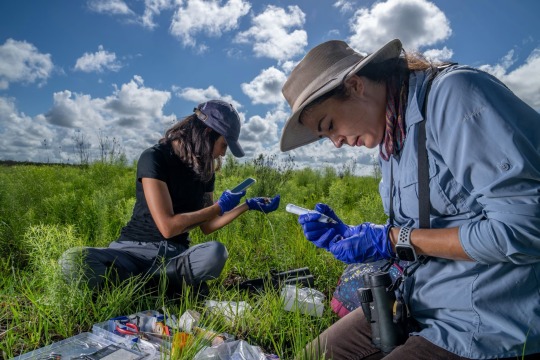
Researchers Fabiola Baeza-Tarin (right) and Nicole Rita (left) place bands on Florida grasshopper sparrows, one of the most endangered bird species in North America. These creatures are making a comeback in the prairies surrounding the Kissimmee River.
Already the biological impact of the project has become clear. As the wetlands have come back, so have the birds. “That response was immediate and pretty impressive,” says Lawrence Glenn, director of water resources with the South Florida Water Management District.
‘Triumph of Imagination’
In all, nearly half of the river has been restored to its original state. The project involved filling in 22 miles of the canal, re-carving sections of the old river, and restoring 44 miles of the waterway’s natural meandering paths, according to the Army Corps.
“It's a triumph of imagination [and] of partnership between the federal government and the state” and other organizations coming together, says Shannon Estenoz, assistant secretary for fish and wildlife and parks with the Department of Interior, who formerly worked for several different environmental organizations in Florida.

Populations of popular game fish, such as bass, have climbed, in part because the water is more oxygenated and invertebrates that demand such conditions, such as mayfly and caddisfly larvae, have returned. Populations of wading and waterbirds are already above intended targets; some species that disappeared during the days of the canal—including ibis, bitterns, avocets, and sandpipers—are back.
The restoration is a grand success story that “shows it’s possible to act at the landscape scale, and [it] demonstrates how quickly ecosystems can recover,” Estenoz adds. And it’s vitally important for water quality and the threatened species that live there, including limpkins, snail kites, and bald eagles, says Congressman Darren Soto, whose district abuts the river.
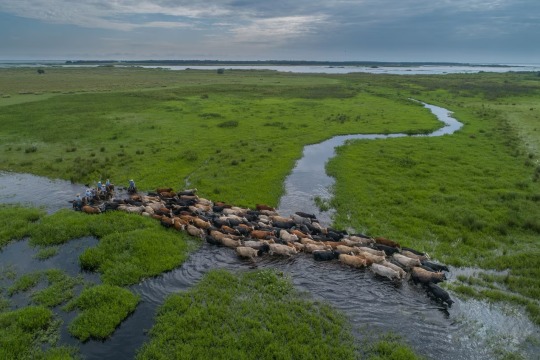
Riders on horseback move cattle across Otter Slough on the Lightsey Ranch with Lake Kissimmee in the background. The Lightsey family has protected more than 90 percent of their land in conservation easements, helping steer development away from sensitive areas in the Everglades Headwaters and Kissimmee River Valley. First receiving cattle and horses from the Spanish in 1521, Florida has the longest history of cattle ranching in the United States.
The Kissimmee will become part of the National Wild and Scenic Rivers System, thanks to an act sponsored by Soto and signed into law as a part of the 2023 Consolidated Appropriations Act. The designation entails special protections and future funding for conservation work.
On the Water
To see the fruits of the restoration myself, I take a late summer ride down the river with photographer and National Geographic Explorer Carlton Ward, Jr., and Adam Bass, vice president of Conservation Florida. The first stretch of the river, directly south of Lake Kissimmee, consists of the old canal—300 feet wide and 30 feet deep, straight as a runway, with almost no birds or wildlife to mention. This part was left as a canal in part to prevent flooding in the Orlando area.
Passing through a lock to get the restored part of the river, the difference is stark and obvious as the river begins its natural flow. The abrupt edges are replaced by thickets and grasses and sabal palms and oaks—and we start seeing birds: herons, egrets, limpkins, and more. Surveys show that there are 50 species of fish in the Kissimmee, nearly 70 species of wetland-dependent birds, over 20 types of reptiles and amphibians, and four mammals that only live in the rehydrated marshes.
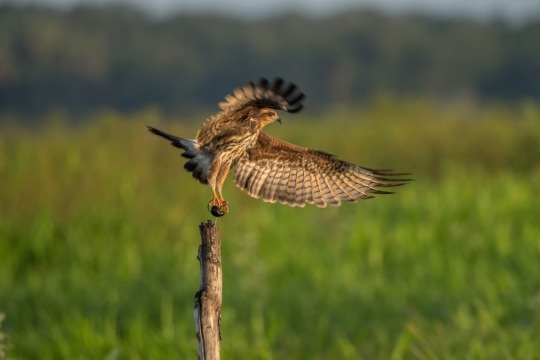
Snail kites are medium-sized hawks that feed on mollusks. They are considered an endangered species in Florida, the northern end of their range. The Kissimmee and its surrounding wetlands are an important habitat for them.
It's the rainy season and the wetlands are flooded, partially submerging vast fields of grasses and flowers. We pass dozens of alligators and bass fishermen. Though we are in crowded South Florida, there are long stretches where we see no people and hear only the sounds of frogs and waterbirds. This is still a wilderness. The river wiggles and bends and sometimes braids, leaving multiple pathways to choose from.
The next morning we wake before dawn and head out. As light creeps over the water nearly 10 snail kites—a subtropical species that’s considered endangered in the United States—fly overhead, many with apple snails in their beaks, large mollusks nearly the size of my fist.
These medium-sized hawks have striking red eyes and hooked beaks; the males are an almost bluish gray, with cream-and-slate undertails, the females a mottled chestnut and white.
Near the town of Lorida, we pull off at the Istokpoga Canal Boat Ramp—one of the only direct ways to access the restored part of the river, and meet Paul Gray, science coordinator with Audubon Florida. He also explains how the restoration project adds 100,000 acre-feet of water storage, which helps prevent flooding, and slows much of the water down, allowing nutrients to settle out.
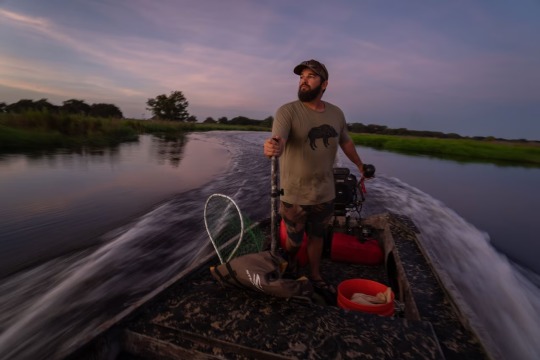
Adam Bass, with Conservation Florida, steers his mud boat through a restored section of the Kissimmee River. With 1,000 people moving to Florida each day and land rapidly being developed, conservationists are working to protect land surrounding the Kissimmee and in the Florida Wildlife Corridor for the benefit of people and wildlife.
One night, we make camp along the river, serenaded by tree frogs and katydids—and watch fireflies flash in an open field, mirrored by twinkles of lightning in a brooding storm cloud on the horizon. Camping in Florida in August is not for the faint of heart, though, as a self-regenerating swarm of mosquitos appears at dusk—the likes of which I’ve never experienced.
Back to the Future
When the channelization was completed in the 1970s, everybody realized it was a mistake. Locals had been against it from the beginning, explains Monrad Chandler, a longtime resident of the area, because “a lot of people used to make a living on the river.”
We’re sitting on a parcel of land he owns right next to the Kissimmee. His son-in-law, Matt Pearce, ranches on this land, where he practices rotational grazing—cattle are currently excluded from this area, allowing the plants to recover and grow back.
“When they channelized the river, there was no marsh no more … then no ducks, no snipe, [no] wading birds,” he says. “A lot of people had to change their livelihood.”
“It was an ecological disaster,” Gray agrees.
But now, those birds are coming back—and the restored section looks essentially the way it used to, Chandler says, fondly recalling hunting and fishing on the river as a youngster.
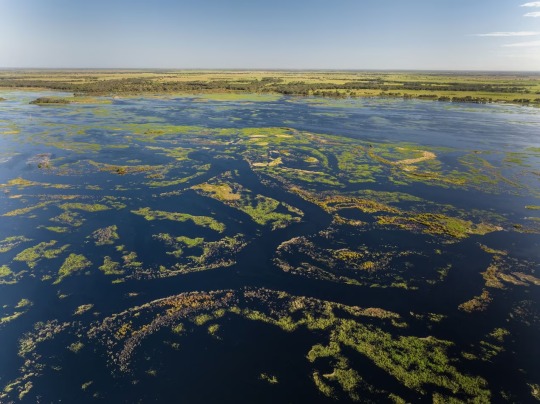
The Kissimmee River and surrounding wetlands flooded after Hurricane Ian. This helped to prevent property damage in developed areas. “The Northern Everglades’ biggest challenge is water storage,” says Paul Gray, science coordinator with Audubon Florida, and these rehydrated wetlands help take excess water.
These restored wetlands provide corridors for larger wildlife such as Florida panthers and bears and habitat for endangered species, including grasshopper sparrows. By storing water, they also help prevent flooding during storms.
“The Kissimmee River accomplished an amazing feat last summer when Hurricane Ian slammed Florida,” Ward says. “It filled to the 100-year flood level and did its job naturally absorbing billions of gallons of water, with no loss of property, because of the restoration efforts.”
Yet there’s still much work to be done. About half of the Kissimmee consists of a canal, and there’s a big backlog of hydrological and research projects. One vital and imminent project involves raising the water level in Lake Kissimmee—and thus increasing water storage.
Gray explains that various areas of Florida—including Orlando—are running out of easily accessible water, draining the state’s aquifers. “These water projects are going to become more and more important for the future of Florida,” Gray says.
“This project is going to be saving water, going to be slowing it down—not only is that a benefit to wildlife, but to water management, and our ability to meet [our] water needs.”
1 note
·
View note
Text
Bothrops bilineatus
Snake
Bothrops bilineatus, also known as the two-striped forest-pitviper, parrotsnake, Amazonian palm viper, or green jararaca, is a highly venomous pit viper species found in the Amazon region of South America. Two subspecies are currently recognized, including the nominate subspecies described here.
Scientific name: Bothriopsis bilineata
Higher classification: Bothriopsis
Bothrops bilineatus - Wikipedia
The Kaw-roura National Nature Reserve: Exceptional Biodiversity

The Kaw marsh is one of six natural reserves in French Guiana, each created by the French state because of its exceptional and unique biodiversity. This wildlife sanctuary has been in existence since the Pleistocene era; until the colonial period, it was only peopled by Native American tribes. The remains of a village, along with vestiges of tools and engraved stones, have also been discovered on Mount Favard. Carbon-14 dating of charred wood and pottery shards shows that the village originated around 170 years AD.
The village of Kaw, a town completely surrounded by wetlands and a floating savannah, is a wild wonderland full of mysteries and surprises. Nicknamed the Everglades of French Guiana, this green kingdom is a bird-watching paradise, home to many species, including large wading birds and herons, as well as one of the biggest members of the order Crocodilia, the black caiman.
Marais de Kaw (Kaw-Roura National Nature Reserve) 97300 Cayenne

Two-striped Forest Pit Viper aka Amazonian Palm Viper (Bothrops bilneatus), family Viperidae, Kaw, French Guiana
Venomous.
photograph by Vincent Prémel
25 notes
·
View notes
Text
Explore America's Colors: Top Vibrant Destinations for Your Ultimate Summer Adventure
VIBRANT ALL-AMERICAN DESTINATIONS TO EXPERIENCE THIS SUMMER
Our minimal social interactions and day-to-day routines at home have created an intense longing for a great escape. Now that the U.S. and many countries are undergoing phased re-openings, we’re optimistic for the future! After all, travel is not merely freeing. It unites, inspires, educates, and is a constant reminder that the diversity of peoples, landscapes, cultures, and cuisines is why we love exploring the U.S. and the world at large. While we can't wait to dust off our passports when the time is right, who needs one when we’re reminded of how much there is to explore in our own backyard? From colorful beaches and jaw-dropping coastlines to otherworldly sights and geologic wonders, below are four uniquely American experiences saturated in natural beauty and intrigue.
“Life is better when lived in full color. Get in touch so we can help you paint new memories with each destination you discover.”
MIAMI, FLORIDA
We'd be remiss not to mention Miami when highlighting colorful U.S. getaways. If gorgeous white sand beaches (now open), cerulean waters, and iconic colorful lifeguard stands are the reason you come, Miami's rich and flavorful culture will be the reason you won't want to leave. It's home to the world's largest collection of Art Deco architecture, arguably the best Cuban sandwiches in the U.S., and nature lovers will appreciate that it is surrounded by both Biscayne and Everglades National Parks. We recommend staying at 1 Hotel South Beach. This property features sweeping views of the Atlantic, which you can view from your stylish and sustainable retreat. Suites were designed using natural, reclaimed materials, ensuring your stay in Miami is one-of-a-kind in every way.
YELLOWSTONE NATIONAL PARK
Magnificent, surreal, unfathomably complex and beautiful... the words that come to mind when describing Yellowstone are as understated as the park is vast. Simply stated, Yellowstone is magical, and it's impossible not to be moved by this immense unspoiled canvas of the American West. If you've been before, you know that experiencing it once is simply not enough, and each visit is life-changing in a new way. Encompassing nearly 3,500 square miles, the park boasts more than half of the active geysers in the world, hundreds of waterfalls, thousands of archaeological sites and hiking trails, and countless opportunities to spot incredible wildlife - including grizzlies! Because this national treasure is wholly exhilarating, we recommend unwinding with a few scoops of huckleberry ice cream at Old Faithful Inn while waiting for its namesake to perform. After watching the sunset at Artist Point overlooking Yellowstone's own Grand Canyon, venture 35 scenic miles north to Sage Lodge, located on the banks of the Yellowstone River. Open now, here you'll sink into true Montana hospitality while you reflect on the day's adventures.
WATCH HILL, RHODE ISLAND
Don't let the size of Rhode Island fool you. The Ocean State is packed full of New England charm. From its sandy shores framed by dune grass blowing in the breeze to its delectable seafood, a visit to "Little Rhody" is sure to leave you as happy as a clam. Discerning travelers should retreat to Ocean House - a destination in and of itself - located in Watch Hill. Famously known for its warm sunny facade, this property opened in 1868 after the Civil War and became the quintessential getaway for travelers looking to spend their summers by the sea at the turn of the century.
Rebuilt to restore its original romance and grandeur, this Relais & Châteaux member is situated on thirteen acres of gorgeous oceanfront bluffs. It also has a private white-sand beach with cabana service and views of Montauk, Block Island, and the Atlantic. Reopening on June 16, be sure your stay includes a Friday so you don’t miss the good old-fashioned New England lobster boil on the beach, complete with a live band.
BIG SUR, CALIFORNIA
The name Big Sur is derived from the Spanish el sur grande, meaning the big South, which refers to its location south of the Monterey Peninsula. Spanning 90 miles, it is the longest stretch of undeveloped coastline in the U.S. and one of the most spectacularly scenic routes in the world. We guarantee your jaw will drop with nearly every winding turn in the road while you chase the sun and watch as waves crash into the jagged shores below. Wander through redwood forests, enjoy a picnic on the beach and watch for humpback whales to breach the surface, and marvel as McWay Falls (pictured above) cascades into the ocean at Julia Pfeiffer Burns State Park. Enjoy a glass of wine and a moonlit evening of stargazing from your private deck or pool at Post Ranch Inn - our recommendation for your accommodation. Renown for its stunning organic architecture, this luxurious and romantic escape will be reopening on July 1 and should not be missed.
MICHAEL SHANE STEPHENS Curated Global Travel An affiliate of Protravel [email protected] 310.691.7468 curatedglobaltravel.com
CONTACT US NOW TO BOOK YOUR NEXT GETAWAY
1 note
·
View note
Photo

365 Marvel Comics Paper Cut-Out SuperHeroes - One Hero, Every Day, All Year…
April 22nd - Man-Thing
Biochemistry professor, Theodore Sallis, was recruited to work on a top secret project in a remote laboratory in the Florida Everglades. Sallis’ assignment, called ‘Project Gladiator’ centered on recreating the super soldier serum that originally imbued Captain America with his powers. Sallis made excellent progress in the endeavor when he realized the program had been infiltrated by agents of A.I.M. Not wanting his research to fall into the hands of these terrorists, Sallis consumed the only sample and fled. His car accidentally crashed into a mysterious swamp and Sallis appeared to have drowned.
The serum he had taken, combined with the mystical properties of the waters, caused Sallis to be transformed into a giant shambling mound composed of swamp flora. This creature possessed incredible strength and resiliency and could also excrete a substance that has a powerful acidic quality when combined the human hormones associated with fear and evil. In other words, the monster’s touch is burning to those who have cowardice or villainy in their heart. The creature Sallis had become, now known as The Man-Thing, made quick work of the villainous agents of AIM who had been pursuing him.
Sallis’ consciousness began to dwindle as he became more a creature of instinct. As though attuned to nature itself, The Man-Thing came to be the protector of a portion of the swamp that included a nexus point that connected its universe to a bevy of different dimensions and realities. As the guardian of this inter-dimensional portal (often referred to as the ‘Nexus of Realities’) The Man-Thing found itself regularly facing demons, ghosts, time-traveling warriors and all manner of menacing threats. Circumstances additionally led to The Man-Thing joining forces with a number of heroes, including Dr. Strange, Jennifer Hale, Howard the Duck and many others. Thew creature also found himself a member of the team of youthful adventurers known as The Daydreamers; as well as a part of the Legion of Monsters.
Some time later, The Man-Thing was captured by the U.S. Government, ultimately leading to Man-Thing becoming a member of a new iteration of The Thunderbolts team. Herein, Man-Thing was forced to utilize its connection to the Nexus so to enable high-speed transportation to The Thunderbolts when dispatched on missions. The Man-Thing has since escaped confinement and returned to the Florida Everglades so to continue its vigilant guardianship of the Nexus.
Man-Thing featured in a 2005 movie where actor Conan Stevens portrayed the titular hero. The Man-Thing first appeared in the pages of Savage Tales #1 (1971).
#365 Marvel Comics Heroes#Marvel Comics#Man-Thing#Thunderbolts#Conan Stevens#cut-out#paper art#Happy Earth Day!
57 notes
·
View notes
Text
The Essential Role of an Expert Customs Broker in Florida
In Florida’s bustling business environment, especially given its strategic location as a major gateway for international trade, the role of an expert customs broker is indispensable. Whether you’re a small business owner importing specialty goods or a large corporation managing complex international shipments, navigating the intricacies of customs regulations can be challenging. This is where a skilled customs broker comes into play. In this article, we’ll delve into why having an expert customs broker in Florida is crucial for efficient and compliant international trade.
What is a Customs Broker?
A customs broker is a licensed professional who facilitates the import and export of goods through customs. They handle the intricate details of compliance with international trade laws, tariffs, and regulations, ensuring that shipments clear customs smoothly and efficiently. In essence, a customs broker acts as an intermediary between businesses and government authorities, providing expertise to navigate the complexities of international trade.
Why an Expert Customs Broker is Essential in Florida
1. Navigating Complex Regulations
Customs regulations are complex and frequently changing. An expert customs broker in Florida has up-to-date knowledge of federal regulations, trade agreements, and customs procedures. They ensure that your shipments comply with the latest rules, reducing the risk of delays, fines, or other penalties.
2. Streamlining Import and Export Processes
Florida is home to several major ports, including the Port of Miami and Port Everglades, which handle a significant volume of international trade. An experienced customs broker can streamline the import and export process, managing paperwork, tariffs, and inspections to expedite the movement of goods through these busy ports.
3. Maximizing Duty and Tax Savings
Customs brokers are skilled in classifying goods accurately and applying the correct tariffs. They can identify opportunities for duty exemptions or reductions under various trade agreements, potentially saving your business significant amounts on import duties and taxes.
4. Ensuring Compliance with Trade Agreements
The U.S. has numerous trade agreements with other countries, such as NAFTA and the USMCA, which can affect the tariffs and duties applied to imports. An expert customs broker stays informed about these agreements and ensures that your shipments benefit from any applicable preferential treatment.
5. Handling Disputes and Appeals
In the event of a customs dispute or audit, having an expert customs broker can be invaluable. They can represent your business in discussions with customs authorities, handle appeals, and resolve issues efficiently, minimizing the impact on your operations.
Key Services Provided by Expert Customs Brokers in Florida
1. Customs Documentation and Filing
Expert brokers prepare and file all necessary customs documentation, including import/export declarations, bills of lading, and certificates of origin. Proper documentation is crucial for avoiding delays and ensuring smooth customs clearance.
2. Tariff Classification and Valuation
They ensure that goods are classified correctly according to the Harmonized System (HS) codes and accurately value shipments to determine the appropriate duties and taxes.
3. Regulatory Compliance
Brokers ensure compliance with all federal regulations and international trade laws, including those related to product safety, environmental standards, and intellectual property rights.
4. Logistics Coordination
Customs brokers often coordinate with freight forwarders, carriers, and other logistics providers to manage the movement of goods from origin to destination, ensuring timely and efficient delivery.
Choosing the Right Customs Broker in Florida
When selecting a customs broker, consider their experience, reputation, and specialization in your industry. An established broker with a track record of success can offer valuable insights and tailored services to meet your specific needs.
Conclusion
In Florida’s dynamic trade environment, partnering with an expert customs broker is crucial for navigating the complexities of international trade. Their expertise in regulations, documentation, and compliance can significantly streamline your business operations, reduce costs, and mitigate risks. By ensuring smooth customs clearance and leveraging their knowledge of trade agreements and tariff classifications, an expert customs broker can be a vital asset in achieving your business goals and maintaining a competitive edge in the global marketplace.
For More Info:-Expert Customs Broker Florida Full Service Customs Brokerage Florida
0 notes
Text
Ilvermorny Campuses
As the No-Maj population in the United States grew so did the wizarding population, with one out of every five thousand people having magical abilities. By 1915 Ilvermorny’s student population was nearing two thousand and the school was quickly reaching its capacity. MACUSA, concerned about what they would do if Ilvermorny did not have room for students, formed the Department of Magical Education or DOME. DOME, comprised of both career politicians as well as former and current teachers, discussed their options. Due to America’s strict wand laws, home schooling across the country did not seem feasible, and the risks of magical children not receiving an education and learning to control their powers were to great.
The department quickly came to the conclusion that the best option was to create an additional Ilvermorny campus. With this, a new campus would be able to be formed with similar enchantments to the original campus, and students would be able to be divided geographically.
The first of the additional campuses was established in 1929. Located in the wilderness of the Olympic Peninsula in Washington, the campus was far from No-Maj reach. With the repeal of Rappaport’s Law in 1965, the US wizarding population was expected to grow even more. Both the Greylock and Olympic campuses were nearing full capacity as well, and DOME determined it was time to build a third campus. The third campus was established in 1972. Maintaining their pattern of hiding within the untamed wilderness, the campus was built in the Gila Wilderness of New Mexico. A fourth campus was built in the Flordia Everglades and established in 1999.
With the building of this campus, the schools got together and decided to create championship leagues between the schools for everything from wizards chess to quodpot. Each school established mascots and team names to play under: The Greyback Snallygasters, the Olympic Sasquatches, the Gila Jackalopes, and the Everglade Raugarous.
#harry potter#harry potter headcanon#ilvermorny#ilvermony school of witchcraft and wizardry#wizarding world#school#fantastic beasts#headcanon
105 notes
·
View notes